Railways of Marple and District From 1794
by WARWICK R. BURTON, M.A.Cantab.
Reproduced with permission from the second edition 1981, published by: M.T. & W.R. BURTON, Marple.
This version of the book was first published on the Marple Website in 2002, with the kind permission of author Warwick Burton and his father Monty, who wrote an addendum for the web site.
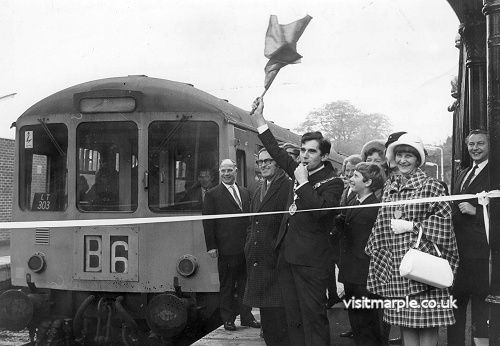 Monty Burton waves the flag at the official reopening of Marple Station on 28 October 1970.
Monty Burton waves the flag at the official reopening of Marple Station on 28 October 1970.
Sadly, both Monty and Warwick have passed away since then. Warwick died in 2015, not long after completing a new version of this book entitled "Railways of Marple and District from the earliest days to 2015". It was republished to coincide with the Marple 150 Festival in 2015, which celebrated 150 years since the railways came to Marple. Warwick came to Marple for the launch of the exhibition in the Library and gave an excellent talk in July 2015, just four months before his unexpected death. This photo by Arthur Procter was taken during that visit:
Warwick Burton at the launch of his new version of this book on 2 July 2015.
The updated version of Warwick's book "Railways of Marple and District from the earliest days to 2015" is currently available from Marple Bookshop, price £15.99
IV. Marple's Expansion. 1872-1889
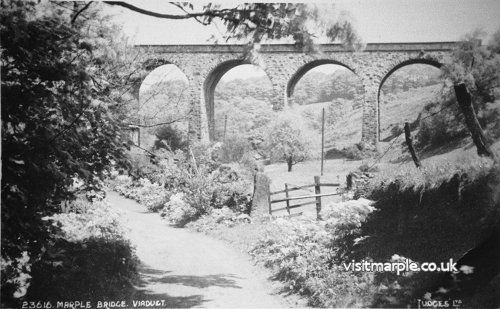 To trace the steps by which Marple now on the Midland through route to Manchester became an important centre on that route we must retrace our steps to 1859. In that year two schemes were floated - the Stockport and Woodley Junction Railway, to run from the M.S.L. at Woodley to a low level station in Stockport, and the Cheshire Midland Railway, an extension of the M.S.J.A. from Altrincham to Northwich. Both were initially locally promoted, but Sir Edward Watkin, the forceful General Manager of the M.S.L., encouraged both these schemes seeing in them a means of occupying territory west of the M.S.L. main line.
To trace the steps by which Marple now on the Midland through route to Manchester became an important centre on that route we must retrace our steps to 1859. In that year two schemes were floated - the Stockport and Woodley Junction Railway, to run from the M.S.L. at Woodley to a low level station in Stockport, and the Cheshire Midland Railway, an extension of the M.S.J.A. from Altrincham to Northwich. Both were initially locally promoted, but Sir Edward Watkin, the forceful General Manager of the M.S.L., encouraged both these schemes seeing in them a means of occupying territory west of the M.S.L. main line.
- Details
- Hits: 7420
V. The Macclesfield Bollington and Marple Railway 1863-1910
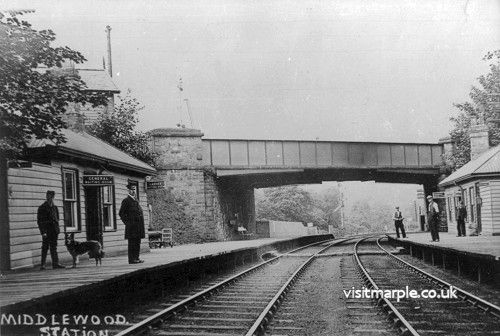 In order to present a continuous narrative of the Midland's drive for Manchester and its effect on Marple Station, no mention has yet been made of the Marple Wharf-Macclesfield line. It is now therefore time to turn to this, the lesser of the two lines serving Marple.
In order to present a continuous narrative of the Midland's drive for Manchester and its effect on Marple Station, no mention has yet been made of the Marple Wharf-Macclesfield line. It is now therefore time to turn to this, the lesser of the two lines serving Marple.
It might be thought that such a line could not possibly equal the railway political significance of the line through Marple, passing through nowhere of any size but Bollington, and enjoying throughout its existence a purely local service. Far from it: the line had an origin as stormy as any, and can be added to the long list of "might-have-beens" as regards Main Line significance.
- Details
- Hits: 10835
VI. Fin de Siècle. Marple's Heyday 1890-1898
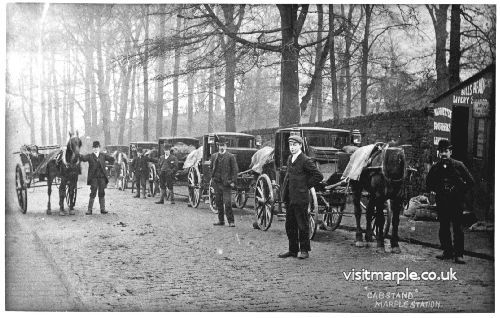 You will recall that Chapter IV ended with the opening of the "Midland Junction" Curve, giving the Midland access to the L. & Y. system. The ever ambitious Midland was not however satisfied with its grip on the North-West; a need was felt for a better link between the new empires in Manchester and Liverpool and the older territories centred on Sheffield and the West Riding. When therefore a local Dore and Chinley line was promoted in the 1880's, the scheme was eagerly snapped up by the Midland, and, with its support, authorised in 1888. Work began immediately, but was slow; for out of the 20½ miles of line, over one quarter - 5¾ miles were in tunnel: Totley Tunnel, at 6,226 yards the second longest tunnel in Britain; Cowburn Tunnel (3,727 yards) by contrast is one of the deepest below ground level.
You will recall that Chapter IV ended with the opening of the "Midland Junction" Curve, giving the Midland access to the L. & Y. system. The ever ambitious Midland was not however satisfied with its grip on the North-West; a need was felt for a better link between the new empires in Manchester and Liverpool and the older territories centred on Sheffield and the West Riding. When therefore a local Dore and Chinley line was promoted in the 1880's, the scheme was eagerly snapped up by the Midland, and, with its support, authorised in 1888. Work began immediately, but was slow; for out of the 20½ miles of line, over one quarter - 5¾ miles were in tunnel: Totley Tunnel, at 6,226 yards the second longest tunnel in Britain; Cowburn Tunnel (3,727 yards) by contrast is one of the deepest below ground level.
- Details
- Hits: 7708
VII. Marple By-Passed 1898-1911
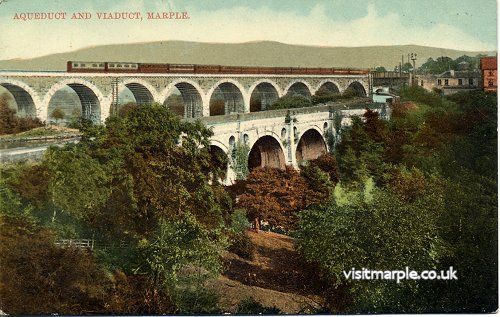 The last decade of the 19th C. had seen a vast increase in the volume of passenger and goods traffic on all the railways of Great Britain; not least on the Midland, and especially on the Main Line via Marple to Manchester and Liverpool. The Midland had arrived late, but had extended its hold by leaps and bounds. Midland passenger and goods trains in the late 90's were much longer, heavier and more frequent than even 10 years before. As a result lines laid down even in the 1860's and 70's were proving inadequate to handle traffic; for instance the section of the Midland Main line from Chinley, where the Hope Valley and Peak lines converged, to Heaton Mersey, where there was the split for Liverpool and Manchester, was becoming increasingly congested; this was particularly serious between New Mills and Stockport, where Midland expresses had to jostle for line space first with G.C. locals as far as Romiley, and then, once on the C. L.C., with another intensive service of passenger and goods trains.
The last decade of the 19th C. had seen a vast increase in the volume of passenger and goods traffic on all the railways of Great Britain; not least on the Midland, and especially on the Main Line via Marple to Manchester and Liverpool. The Midland had arrived late, but had extended its hold by leaps and bounds. Midland passenger and goods trains in the late 90's were much longer, heavier and more frequent than even 10 years before. As a result lines laid down even in the 1860's and 70's were proving inadequate to handle traffic; for instance the section of the Midland Main line from Chinley, where the Hope Valley and Peak lines converged, to Heaton Mersey, where there was the split for Liverpool and Manchester, was becoming increasingly congested; this was particularly serious between New Mills and Stockport, where Midland expresses had to jostle for line space first with G.C. locals as far as Romiley, and then, once on the C. L.C., with another intensive service of passenger and goods trains.
- Details
- Hits: 11048
VIII. A Changing World 1911-1939
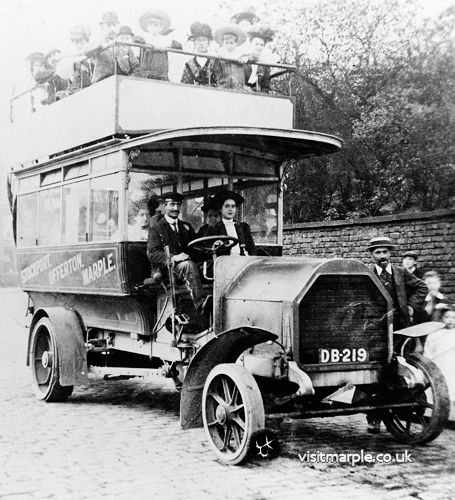 The first signs of a changing world came in 1911 in a great national railway strike which began in the North West of England; this not only showed that railwaymen were tired of long hours and low pay, but were now sufficiently organised to demand better conditions on a national level - and get them. This was followed in 1912 by a coal strike, which had a very serious effect on the railways.
The first signs of a changing world came in 1911 in a great national railway strike which began in the North West of England; this not only showed that railwaymen were tired of long hours and low pay, but were now sufficiently organised to demand better conditions on a national level - and get them. This was followed in 1912 by a coal strike, which had a very serious effect on the railways.
Outside the station horsedrawn cabs and carriages might still wait to meet passengers, but the early years of the 2Oth C, saw the start of privately owned petrol driven omnibuses. At first in Marple, as elsewhere, they connected with trains and ran from Marple Station to Mellor, Compstall, and Hawk Green. But soon the operators realised that where the railway service was poor, infrequent or indirect, they could draw passengers from the railway - and so the 1900's saw the start of a bus service between Marple and Stockport, where the bus could provide a service much more convenient and not much slower. As yet buses were unreliable and uncomfortable, but it was an augury for the future.
- Details
- Hits: 6307
IX. World War II and Nationalisation 1939-1961
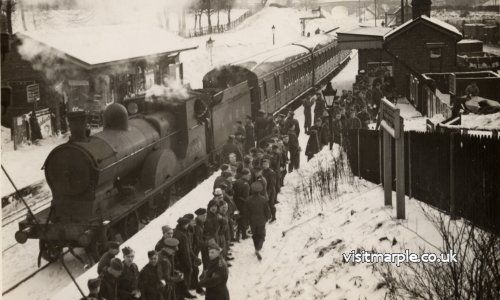 Once again at the start of hostilities the railways came under Government control. At first there was something of a panic -the "phoney war" - and savage cuts were made in services: from 1st November 1939 the L.N.E.R. reduced its services from London Road to Marple from 32 to 20, and on the Macclesfield line from 13 to 8, while all but one of the Rose Hill turn-backs were withdrawn. These cuts were later seen to be somewhat excessive, and even by the end of the war more services were running than in late 1939.
Once again at the start of hostilities the railways came under Government control. At first there was something of a panic -the "phoney war" - and savage cuts were made in services: from 1st November 1939 the L.N.E.R. reduced its services from London Road to Marple from 32 to 20, and on the Macclesfield line from 13 to 8, while all but one of the Rose Hill turn-backs were withdrawn. These cuts were later seen to be somewhat excessive, and even by the end of the war more services were running than in late 1939.
- Details
- Hits: 7726




